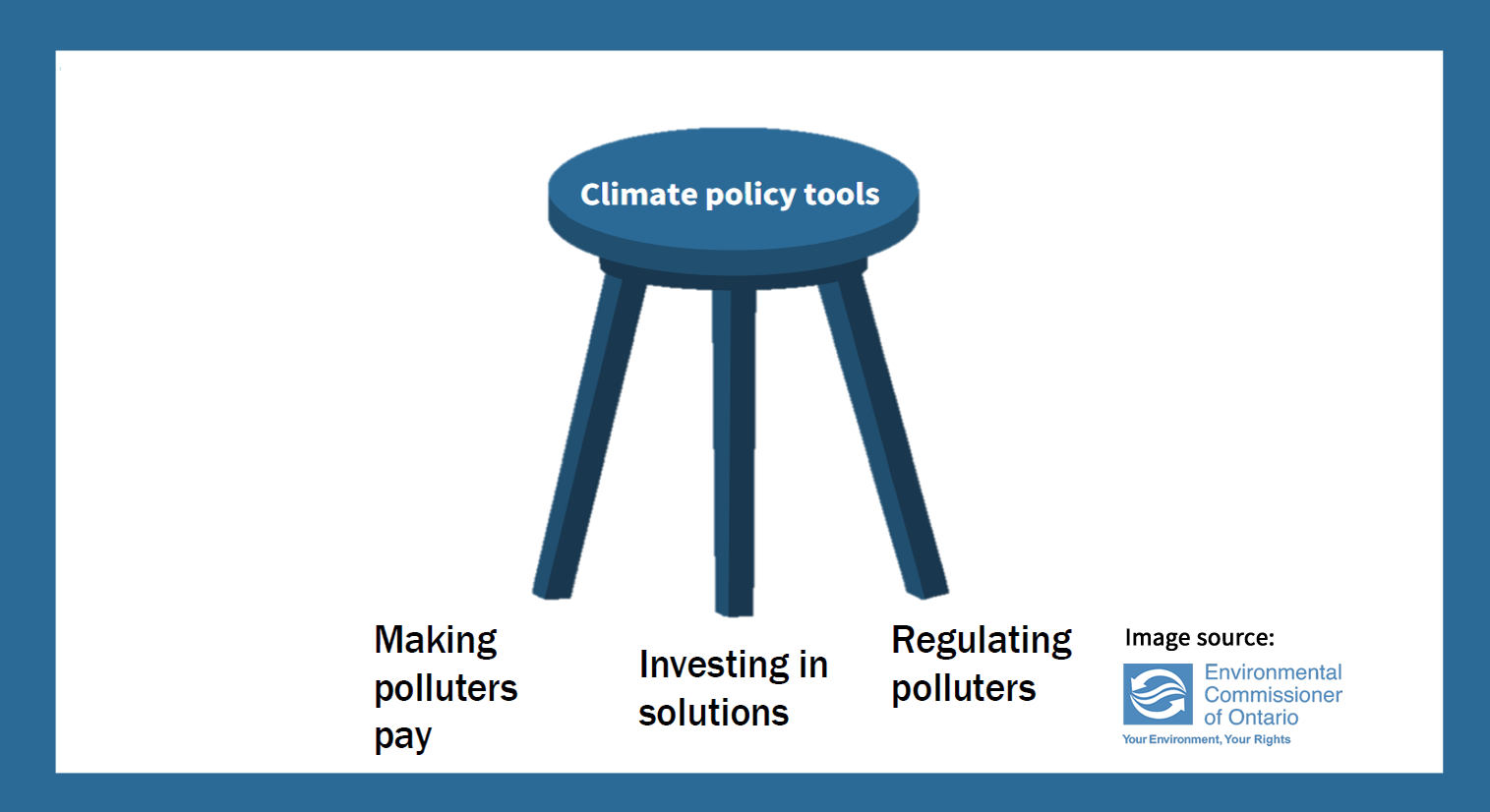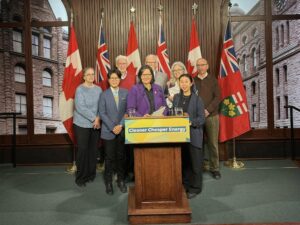Anyone who is serious about climate action and climate solutions must absolutely support the carbon pricing fee and dividend approach. Here’s why. 1. It’s a method of redistributing money from high carbon emitters to lower carbon emitters. Something like 70% of households will get more back than the additional costs they incur because of the carbon price. Redistributing money is progressive, not regressive. 2. Carbon pricing is one of three main strategies endorsed by the Environmental Commissioner of Ontario, in what she calls the “three-legged stool”. The other two legs are regulations and investment. We won’t make progress on the climate emergency by knocking out one of the legs of the stool. Commissioner Dianne Saxe said carbon pricing was working in Ontario, and that fee and dividend is a valid alternative method to cap-and-trade, which was working until the Ford government killed it off with Bill 4. 3. Grassroot activists have been working for eight years to achieve this one leg of the stool at the federal level, and it has finally been adopted by the Trudeau government. We all wish they would stop buying pipelines, end all fossil fuel subsidies, and invest more in renewables. They’re doing some of this, and we should push them for more! But to fight against the one definite win by Citizens’ Climate Lobby and other citizen lobbyists is cruel and self-defeating. Instead, advocate for the leg of the stool you want—rather than attacking the climate community’s biggest win, learn from and emulate the organized lobby that made it happen. 5. Some critics of carbon pricing say it won’t make enough difference to be worth the effort. They often forget to mention that the price is meant to rise over time, and it’ll have an impact on investment decisions once the price signal is there. In Ontario, investing carbon price revenue in low-carbon projects had an immediate, incredibly positive impact at the community level. 6. Going right back to first principles—carbon pricing is no more or less than a way to put a price on pollution, to correct the mismatch between the things we need and want and the signals our economy sends. Suddenly we’re against that? 7. It’s important to listen to concerns about the impact of carbon pricing on people with very low incomes. There should be a program of assistance available to those who need immediate, monthly relief, rather than waiting for an income tax refund. That’s an improvement we can and should advocate for. But social justice advocates have to be careful about aligning with all-purpose carbon price opponents who just want to slow down or stop any policy that threatens fossil fuel profits. 8. What happens in Canada this year will truly affect the world. Other countries are watching to see if the federal government can successfully implement fee and dividend carbon pricing and not get kicked out of power. If Canada is successful, the strategy will spread—possibly even to the United States, where it’s one of the few approaches gaining support from both parties in Congress. 9. There are better and worse forms of carbon pricing and carbon trading, but it’s a mistake to let the perfect be the enemy of the good. Carbon pricing sends a signal that carbon pollution cannot just be emitted for free. Yes, some large emitters are getting a break on their carbon fee, but as a larger proportion of the world’s economies adopt their own pricing systems, and tools like aborder tax adjustmentbecome a reality, those exemptions will disappear. 10. California is by no means doing everything right, but theyreachedtheir 2020 climate target in 2016. Do they need more ambitious targets? Yes. Did cap-and-trade help them make progress in cutting emissions? Yes, it did. Do they also need to do other things, like phase out oil and gas development? Yes, they do—but that doesn’t make the carbon price a bad thing. It just means an emergency as big as climate change calls for a multi-pronged response, we need multiple tools in the toolbox, and we can’t afford to throw any of them away.10 ARGUMENTS FOR CARBON PRICING: ‘DON’T THROW ANY TOOL OUT OF THE TOOLBOX’
 4. The Liberals are going to run with carbon pricing in their platform, and the Tories are going to fight it. Neither the New Democrats nor the Greens will form the next federal government, though their climate and carbon pricing policies will matter in ridings where they’re running strong. If you fight it, you help a political party whose leader has just walked back any commitment to meeting Canada’s already-inadequate targets under the Paris Agreement. We’ve seen the Doug Ford government trash a carbon “tax” that was being invested in hundreds of job-creating renewable projects, virtually all of which have now been cancelled, after winning an election on rhetoric that vilified carbon pricing. Is that what you want for the rest of Canada?
4. The Liberals are going to run with carbon pricing in their platform, and the Tories are going to fight it. Neither the New Democrats nor the Greens will form the next federal government, though their climate and carbon pricing policies will matter in ridings where they’re running strong. If you fight it, you help a political party whose leader has just walked back any commitment to meeting Canada’s already-inadequate targets under the Paris Agreement. We’ve seen the Doug Ford government trash a carbon “tax” that was being invested in hundreds of job-creating renewable projects, virtually all of which have now been cancelled, after winning an election on rhetoric that vilified carbon pricing. Is that what you want for the rest of Canada?
BLOG: 10 ARGUMENTS FOR CARBON PRICING: ‘DON’T THROW ANY TOOL OUT OF THE TOOLBOX’- By Lyn Adamson
Home » CCL Canada News » BLOG: 10 ARGUMENTS FOR CARBON PRICING: ‘DON’T THROW ANY TOOL OUT OF THE TOOLBOX’- By Lyn Adamson
BLOG: 10 ARGUMENTS FOR CARBON PRICING: ‘DON’T THROW ANY TOOL OUT OF THE TOOLBOX’- By Lyn Adamson
Posted on February 24, 2019 in Blog
After a multi-year fight for political acceptance, carbon pricing is suddenly under attack from all sides of the political spectrum. Lyn Adamson, co-chair of Toronto-based Climate Fast and member of Citizens’ Climate Lobby, has 10 reasons not to abandon a key tool in the climate action toolbox.






